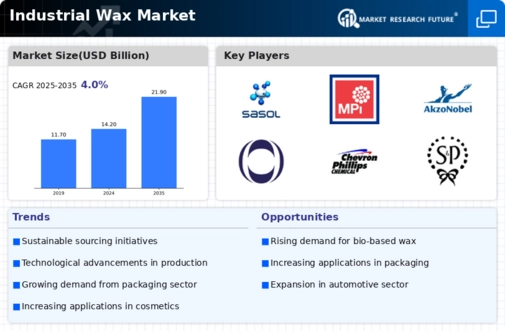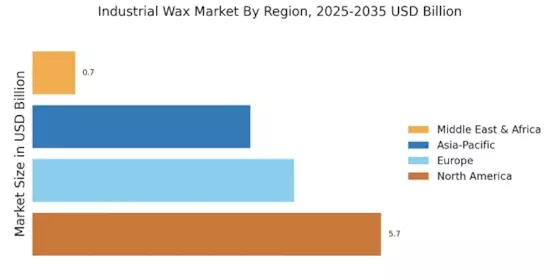Rising Demand from End-User Industries
The Industrial Wax Market experiences a notable surge in demand from various end-user sectors, including packaging, cosmetics, and automotive. The packaging industry, in particular, is projected to account for a substantial share of the market, driven by the increasing need for sustainable and efficient packaging solutions. As companies strive to enhance product presentation and shelf life, the use of industrial waxes in coatings and sealants becomes more prevalent. Furthermore, the cosmetics sector is witnessing a growing inclination towards natural and organic waxes, which are perceived as safer alternatives. This trend is likely to bolster the market, as consumers increasingly favor products that align with their health and environmental values. Overall, the rising demand from these diverse industries is expected to propel the growth of the Industrial Wax Market.
Sustainability and Eco-Friendly Products
The Industrial Wax Market is increasingly influenced by the growing emphasis on sustainability and eco-friendly products. As consumers become more environmentally conscious, there is a rising demand for waxes derived from renewable resources. This shift is prompting manufacturers to explore bio-based alternatives and sustainable sourcing practices. The market for eco-friendly industrial waxes is projected to expand, driven by the need for products that minimize environmental impact. Furthermore, regulatory pressures aimed at reducing plastic usage and promoting sustainable materials are likely to accelerate this trend. Companies that prioritize sustainability in their product offerings may find themselves well-positioned to capture market share in the evolving Industrial Wax Market. This focus on eco-friendly solutions not only meets consumer expectations but also aligns with broader environmental goals.
Innovations in Wax Production Technologies
Technological advancements play a pivotal role in shaping the Industrial Wax Market. Innovations in production processes, such as the development of bio-based waxes and advanced refining techniques, are enhancing the quality and sustainability of wax products. For instance, the introduction of environmentally friendly production methods is likely to attract a broader customer base, particularly among eco-conscious consumers and businesses. Additionally, the integration of automation and smart technologies in manufacturing processes is expected to improve efficiency and reduce costs. As a result, companies that adopt these innovations may gain a competitive edge in the market. The ongoing research and development efforts aimed at creating high-performance waxes tailored for specific applications further indicate a promising future for the Industrial Wax Market.
Increasing Applications in the Food Industry
The Industrial Wax Market is experiencing growth due to its expanding applications in the food sector. Waxes are increasingly utilized in food packaging, coatings, and preservation, contributing to enhanced product quality and shelf life. For instance, food-grade waxes are employed in the coating of fruits and vegetables to prevent moisture loss and maintain freshness. The rising consumer demand for convenience foods and packaged goods is likely to further drive the need for industrial waxes in food applications. Additionally, as food safety regulations become more stringent, the use of compliant and safe waxes is expected to gain traction. This trend indicates a promising outlook for the Industrial Wax Market, as it aligns with the growing emphasis on food quality and safety.
Growth of the Personal Care and Cosmetics Sector
The Industrial Wax Market is significantly influenced by the expansion of the personal care and cosmetics sector. With the increasing consumer awareness regarding personal grooming and beauty products, the demand for waxes used in formulations such as lip balms, creams, and lotions is on the rise. According to recent estimates, the personal care industry is expected to witness a compound annual growth rate of over 5% in the coming years, which directly correlates with the demand for industrial waxes. Furthermore, the trend towards natural and organic ingredients in cosmetics is likely to drive the adoption of plant-based waxes, thereby enhancing the market's growth potential. As brands strive to meet consumer preferences for clean and sustainable products, the Industrial Wax Market stands to benefit from this evolving landscape.


















Leave a Comment